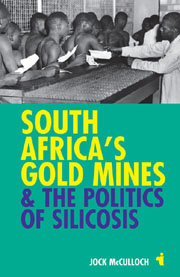Book contents
- Frontmatter
- Contents
- List of Photographs
- Preface: South Africa in the Twentieth Century
- Acknowledgments
- List of Abbreviations
- A Brief Chronology
- 1 Gold Mining & Life-Threatening Disease
- 2 Creating a Medical System
- 3 Compensation
- 4 A White Science
- 5 Myth Making & the 1930 Silicosis Conference
- 6 Tuberculosis & Tropical Labour
- 7 Conflict over the Compensation System
- 8 Healing Miners
- 9 The Sick Shall Work
- 10 Men Without Qualities
- Select Bibliography
- Index
6 - Tuberculosis & Tropical Labour
Published online by Cambridge University Press: 05 February 2013
- Frontmatter
- Contents
- List of Photographs
- Preface: South Africa in the Twentieth Century
- Acknowledgments
- List of Abbreviations
- A Brief Chronology
- 1 Gold Mining & Life-Threatening Disease
- 2 Creating a Medical System
- 3 Compensation
- 4 A White Science
- 5 Myth Making & the 1930 Silicosis Conference
- 6 Tuberculosis & Tropical Labour
- 7 Conflict over the Compensation System
- 8 Healing Miners
- 9 The Sick Shall Work
- 10 Men Without Qualities
- Select Bibliography
- Index
Summary
The 1930 Silicosis Conference had publicised the safety of the mines, but it was insufficient to justify the return of Tropicals. To do so the industry needed proof that the mines would not incubate tuberculosis and spread infection to rural areas. While the Conference was in session, Dr Peter Allan was conducting fieldwork in the Ciskei and the Transkei for the South African Institute of Medical Research (SAIMR) inquiry. The report, published in 1932, was the first of its kind since Turner's in 1906, and it was to be the last in the public domain until majority rule.
The project was funded by the Chamber of Mines, and the report was written by the Tuberculosis Research Committee, whose membership was dominated by men tied professionally to the industry. The report titled Tuberculosis in South African Natives began with the official data showing that the tuberculosis rate in black gold miners had been falling for more than a decade: by 1930 it was reportedly down to 0.7 per cent per year. Many European countries had similar rates for the same age-group, suggesting that tuberculosis was no longer a problem. The Committee agreed that the clinical profiles of African and European miners differed markedly. The most notable differences were the high prevalence in first-time black recruits, accompanied by a mortality rate of more than 70 per cent within two years of diagnosis.
- Type
- Chapter
- Information
- South Africa's Gold Mines and the Politics of Silicosis , pp. 85 - 105Publisher: Boydell & BrewerPrint publication year: 2012



